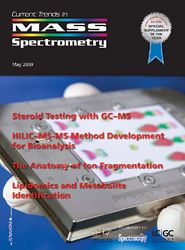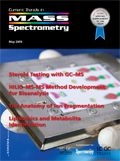TOC
TOC
Cover image courtesy of Bruker Daltonics, Billerica, Massachusetts.

Departments
From the Editor 6
Products 49
Ad Index 50
Articles
57th ASMS Conference Preview 10
Helen A. Castro
Accelerated Discovery and Quantitation of Lipids in Complex Extracts 12
Brigitte Simons, Gary Impey, and Eva Duchoslav
Anatomy of an Ion's Fragmentation After Electron Ionization, Part I 18
O. David Sparkman, Patrick R. Jones, and Matthew Curtis
High Performance Mass Spectrometry for Small Molecule and Protein Applications 30
Darwin Asa
The Role of Triple Quadrupole GC–MS in Steroid Analysis 33
Aishah Latiff and Melissa Churley
Using High-Resolution LC–MS to Analyze Complex Sample 38
Markus Kellman, Andreas Wieghaus, Helmut Muenster, Lester Taylor, and Dipankar Ghosh
Structured Approach to Method Development for Bioanalytical HILIC–MS-MS Applications 44
A. Carl Sanchez and Monika Kansal

LIBS Illuminates the Hidden Health Risks of Indoor Welding and Soldering
April 23rd 2025A new dual-spectroscopy approach reveals real-time pollution threats in indoor workspaces. Chinese researchers have pioneered the use of laser-induced breakdown spectroscopy (LIBS) and aerosol mass spectrometry to uncover and monitor harmful heavy metal and dust emissions from soldering and welding in real-time. These complementary tools offer a fast, accurate means to evaluate air quality threats in industrial and indoor environments—where people spend most of their time.
NIR Spectroscopy Explored as Sustainable Approach to Detecting Bovine Mastitis
April 23rd 2025A new study published in Applied Food Research demonstrates that near-infrared spectroscopy (NIRS) can effectively detect subclinical bovine mastitis in milk, offering a fast, non-invasive method to guide targeted antibiotic treatment and support sustainable dairy practices.
Smarter Sensors, Cleaner Earth Using AI and IoT for Pollution Monitoring
April 22nd 2025A global research team has detailed how smart sensors, artificial intelligence (AI), machine learning, and Internet of Things (IoT) technologies are transforming the detection and management of environmental pollutants. Their comprehensive review highlights how spectroscopy and sensor networks are now key tools in real-time pollution tracking.